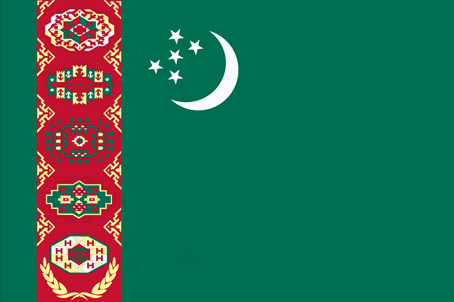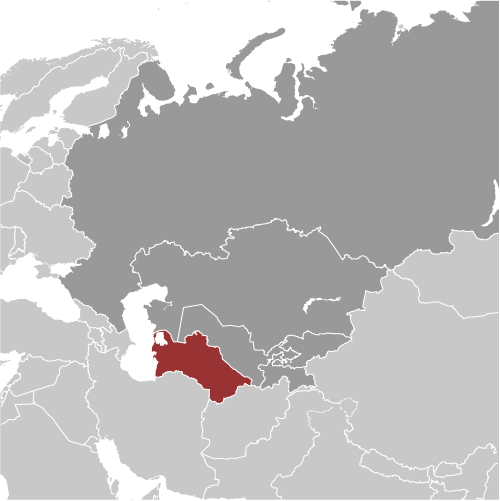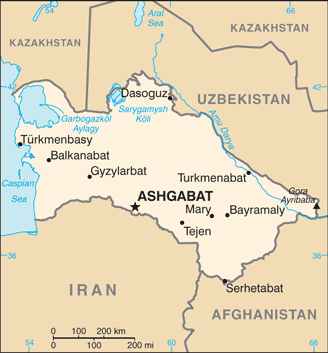|
Economy - overview:
|

|
|
Turkmenistan is largely a desert country with intensive agriculture in irrigated oases and sizeable gas and oil resources. The two largest crops are cotton, most of which is produced for export, and wheat, which is domestically consumed. Although agriculture accounts for roughly 8% of GDP, it continues to employ nearly half of the country's workforce. Turkmenistan's authoritarian regime has taken a cautious approach to economic reform, hoping to use gas and cotton export revenues to sustain its inefficient and highly corrupt economy. Privatization goals remain limited. From 1998-2005, Turkmenistan suffered from the continued lack of adequate export routes for natural gas and from obligations on extensive short-term external debt. At the same time, however, total exports rose by an average of roughly 15% per year from 2003-08, largely because of higher international oil and gas prices. Additional pipelines to China, that began operation in early 2010, and increased pipeline capacity to Iran, have expanded Turkmenistan's export routes for its gas. Overall prospects in the near future are discouraging because of endemic corruption, a poor educational system, government misuse of oil and gas revenues, and Ashgabat's reluctance to adopt market-oriented reforms. The majority of Turkmenistan's economic statistics are state secrets. The present government established a State Agency for Statistics, but GDP numbers and other publicized figures are subject to wide margins of error. In particular, the rate of GDP growth is uncertain. Since his election, President BERDIMUHAMEDOW unified the country's dual currency exchange rate, ordered the redenomination of the manat, reduced state subsidies for gasoline, and initiated development of a special tourism zone on the Caspian Sea. Although foreign investment is encouraged, and some improvements in macroeconomic policy have been made, numerous bureaucratic obstacles impede international business activity.
|
|
|
GDP (purchasing power parity):
|

|
|
$47.55 billion (2012 est.)
country comparison to the world: 97
$44.04 billion (2011 est.)
$38.41 billion (2010 est.)
note:
data are in 2012 US dollars
|
|
|
GDP (official exchange rate):
|

|
|
$33.47 billion (2012 est.)
|
|
|
GDP - real growth rate:
|

|
|
8% (2012 est.)
country comparison to the world: 17
14.7% (2011 est.)
9.2% (2010 est.)
|
|
|
GDP - per capita (PPP):
|

|
|
$8,500 (2012 est.)
country comparison to the world: 127
$8,000 (2011 est.)
$7,100 (2010 est.)
note:
data are in 2012 US dollars
|
|
|
GDP - composition by sector:
|

|
|
agriculture: 7.6%
industry:
24.4%
services:
68% (2012 est.)
|
|
|
Labor force:
|

|
|
2.3 million (2008 est.)
country comparison to the world: 117
|
|
|
Labor force - by occupation:
|

|
|
agriculture: 48.2%
industry:
14%
services:
37.8% (2004 est.)
|
|
|
Unemployment rate:
|

|
|
60% (2004 est.)
country comparison to the world: 198
|
|
|
Population below poverty line:
|

|
|
30% (2004 est.)
|
|
|
Household income or consumption by percentage share:
|

|
|
lowest 10%: 2.6%
highest 10%:
31.7% (1998)
|
|
|
Distribution of family income - Gini index:
|

|
|
40.8 (1998)
country comparison to the world: 56
|
|
|
Investment (gross fixed):
|

|
|
9.3% of GDP (2012 est.)
country comparison to the world: 150
|
|
|
Budget:
|

|
|
revenues: $26.4 billion
expenditures:
$26.9 billion (2012 est.)
|
|
|
Taxes and other revenues:
|

|
|
78.9% of GDP (2012 est.)
country comparison to the world: 3
|
|
|
Budget surplus (+) or deficit (-):
|

|
|
-1.5% of GDP (2012 est.)
country comparison to the world: 70
|
|
|
Inflation rate (consumer prices):
|

|
|
10.5% (2012 est.)
country comparison to the world: 202
12% (2011 est.)
|
|
|
Stock of narrow money:
|

|
|
$828.8 million (31 December 2012 est.)
country comparison to the world: 152
$723.9 million (31 December 2011 est.)
|
|
|
Stock of broad money:
|

|
|
$1.652 billion (31 December 2012 est.)
country comparison to the world: 155
$1.41 billion (31 December 2011 est.)
|
|
|
Stock of domestic credit:
|

|
|
$3.895 billion (31 December 2012 est.)
country comparison to the world: 124
$3.298 billion (31 December 2011 est.)
|
|
|
Market value of publicly traded shares:
|

|
|
$NA
|
|
|
Agriculture - products:
|

|
|
cotton, grain, melons; livestock
|
|
|
Industries:
|

|
|
natural gas, oil, petroleum products, textiles, food processing
|
|
|
Industrial production growth rate:
|

|
|
7.3% (2010 est.)
country comparison to the world: 35
|
|
|
Current account balance:
|

|
|
$1.496 billion (2012 est.)
country comparison to the world: 39
$1.005 billion (2011 est.)
|
|
|
Exports:
|

|
|
$16.16 billion (2012 est.)
country comparison to the world: 80
$14.78 billion (2011 est.)
|
|
|
Exports - commodities:
|

|
|
gas, crude oil, petrochemicals, textiles, cotton fiber
|
|
|
Exports - partners:
|

|
|
China 59.2%, Turkey 5%, Italy 4.7%, UAE 4.3% (2011)
|
|
|
Imports:
|

|
|
$10.43 billion (2012 est.)
country comparison to the world: 96
$9.604 billion (2011 est.)
|
|
|
Imports - commodities:
|

|
|
machinery and equipment, chemicals, foodstuffs
|
|
|
Imports - partners:
|

|
|
Turkey 21%, Russia 14%, China 11.1%, UAE 7.9%, Germany 5.8% (2011)
|
|
|
Reserves of foreign exchange and gold:
|

|
|
$20.68 billion (31 December 2012 est.)
country comparison to the world: 58
$19.4 billion (31 December 2011 est.)
|
|
|
Debt - external:
|

|
|
$429.1 million (31 December 2012 est.)
country comparison to the world: 174
$452.9 million (31 December 2011 est.)
|
|
|
Exchange rates:
|

|
|
Turkmen manat (TMM) per US dollar -
2.85 (2012 est.)
2.85 (2011 est.)
2.85 (2010 est.)
2.85 (2009)
14,250 (2008)
|
|
|
Fiscal year:
|

|
|
calendar year
|
|
|
|





 )
)



